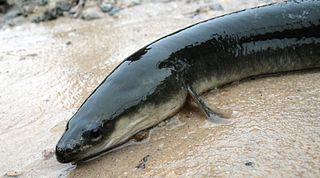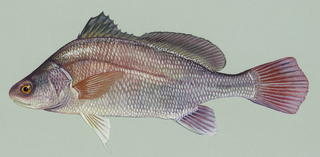
Catfish are a diverse group of ray-finned fish. Named for their prominent barbels, which resemble a cat's whiskers, catfish range in size and behavior from the three largest species alive, the Mekong giant catfish from Southeast Asia, the wels catfish of Eurasia, and the piraíba of South America, to detritivores, and even to a tiny parasitic species commonly called the candiru, Vandellia cirrhosa. Neither the armour-plated types nor the naked types have scales. Despite their name, not all catfish have prominent barbels or "whiskers". Members of the Siluriformes order are defined by features of the skull and swimbladder. Catfish are of considerable commercial importance; many of the larger species are farmed or fished for food. Many of the smaller species, particularly the genus Corydoras, are important in the aquarium hobby. Many catfish are nocturnal, but others are crepuscular or diurnal.

The American eel is a facultative catadromous fish found on the eastern coast of North America. Freshwater eels are fish belonging to the elopomorph superorder, a group of phylogenetically ancient teleosts. The American eel has a slender, supple, snake-like body that is covered with a mucus layer, which makes the eel appear to be naked and slimy despite the presence of minute scales. A long dorsal fin runs from the middle of the back and is continuous with a similar ventral fin. Pelvic fins are absent, and relatively small pectoral fins can be found near the midline, followed by the head and gill covers. Variations exist in coloration, from olive green, brown shading to greenish-yellow and light gray or white on the belly. Eels from clear water are often lighter than those from dark, tannic acid streams.

The widemouth blindcat is a species of North American freshwater catfish endemic to Texas in the United States. It is the only species in the genus Satan.

The Ictaluridae, sometimes called ictalurids, are a family of catfish native to North America, where they are an important food source and sometimes fished for sport. The family includes about 51 species, some commonly known as bullheads, madtoms, channel catfish, and blue catfish.

The brown bullhead is a fish of the family Ictaluridae that is widely distributed in North America. It is a species of bullhead catfish and is similar to the black bullhead and yellow bullhead. It was originally described as Pimelodus nebulosus by Charles Alexandre Lesueur in 1819, and is also referred to as Ictalurus nebulosus.

The channel catfish is North America's most numerous catfish species. It is the official fish of Kansas, Missouri, Nebraska, and Tennessee, and is informally referred to as a "channel cat". In the United States, they are the most fished catfish species with around 8 million anglers targeting them per year. They also have very few teeth and swallow food whole. The popularity of channel catfish for food has contributed to the rapid expansion of aquaculture of this species in the United States. It has also been widely introduced in Europe, Asia and South America, and it is legally considered an invasive species in many countries.

The blue catfish is a large species of North American catfish, reaching a length of 65 in (170 cm) and a weight of 165 lb (75 kg). The continent’s largest, it can live to 20 years, with a typical fish being between 25–46 in (64–117 cm) and 30–70 lb (14–32 kg). Native distribution is primarily in the Mississippi River and Louisiana drainage systems, including the Missouri, Ohio, Tennessee, and Arkansas Rivers, the Des Moines River in south-central Iowa, the Rio Grande, and south along the Gulf Coast to Belize and Guatemala.

The sauger is a freshwater perciform fish of the family Percidae that resembles its close relative, the walleye. The species is a member of the largest vertebrate order, the Perciformes. It is the most migratory percid species in North America. Saugers have two dorsal fins; the first is spiny and the posterior dorsal fin is soft-rayed. Their paired fins are in the thoracic position and their caudal fin is truncated, which means squared off at the corners, a characteristic of the family Percidae. Another physical characteristic of saugers is their ctenoid scales, which are common in advanced fishes. Saugers have a fusiform body structure, and as a result are well adapted predatory fishes and are capable of swimming into fast currents with minimal drag on their bodies. They may be distinguished from walleyes by the distinctly spotted dorsal fin, by the lack of a white splotch on the caudal fin, by the rough skin over their gills, and by their generally more brassy color, or darker color in some regions. The typical sauger is 300 to 400 g in weight.

The freshwater drum, Aplodinotus grunniens, is a fish endemic to North and Central America. It is the only species in the genus Aplodinotus, and is a member of the family Sciaenidae. It is the only North American member of the group that inhabits freshwater for its entire life. Its generic name, Aplodinotus, comes from Greek meaning "single back", and the specific epithet, grunniens, comes from a Latin word meaning "grunting". It is given to it because of the grunting noise that mature males make. This noise comes from a special set of muscles within the body cavity that vibrate against the swim bladder. The purpose of the grunting is unknown, but due to it being present in only mature males and during the spawning season, it is assumed to be linked to spawning.

The gafftopsail catfish is a species of marine catfish found in the waters of the western central Atlantic Ocean, as well as the Gulf of Mexico and the Caribbean Sea. It has long, venomous spines which can cause painful wounds. It feeds on crustaceans and other fish. The male of the species fertilizes the eggs of the female, and broods them in his mouth until they hatch. The gafftopsail feeds throughout the water column. This fish is a common catch in the Southeastern US, although it may be found as far north as New York. They are considered strong fighters by anglers. They are taken from piers, jetties, reefs, and the surf, as well as bottom fishing or flats fishing. They are caught with hard lures as well as soft plastics, cut bait, and live or dead shrimp. Some fishermen use traps for catfish, a method regulated by some states.

The black bullhead or black bullhead catfish is a species of bullhead catfish. Like other bullhead catfish, it has the ability to thrive in waters that are low in oxygen, brackish, turbid and/or very warm. It also has barbels located near its mouth, a broad head, spiny fins, and no scales. It can be identified from other bullheads as the barbels are black, and it has a tan crescent around the tail. Its caudal fin is truncated. Like virtually all catfish, it is nocturnal, preferring to feed at night, although young feed during the day. It generally does not get as large as the channel or blue catfish, with average adult weights are in the 1-to-2-pound range, and almost never as large as 4 pounds (1.8 kg). It has a typical length of 6–14 inches (15–36 cm), with the largest specimen being 24 inches (61 cm), making it the largest of the bullheads. It is typically black or dark brown on the dorsal side of its body and yellow or white on the ventral side.

Ameiurus is a genus of catfishes in the family Ictaluridae. It contains the three common types of bullhead catfish found in waters of the United States, the black bullhead, the brown bullhead, and the yellow bullhead, as well as other species, such as the white catfish, which are not typically called "bullheads".

The threadfin shad is a small pelagic freshwater forage fish common in lakes, large streams and reservoirs of the Southeastern United States. Like the American gizzard shad, the threadfin shad has an elongated dorsal fin, but unlike the gizzard shad, its mouth is more terminal without a projecting upper jaw. The fins of threadfin shad often have a yellowish color, especially the caudal fin. The back is grey to blue with a dark spot on the shoulder. D. petenense is more often found in moving water, and is rarely found deep in the water column. It occurs in large schools, sometimes with gizzard shad, and can be seen on the surface at dawn and dusk. The threadfin shad may reach lengths of 8 in (200 mm), but only rarely. This fish is very sensitive to changes in temperature and dissolved oxygen, and die-offs are frequent in late summer and fall, especially when water temperature drops to 42 °F. The threadfin shad is a favorite food for many game fishes, including striped bass, largemouth bass, smallmouth bass, and catfish. This fish is widely introduced throughout the United States as a forage for game fish.

The Sonora Sucker, Catostomus insignis, is a medium-sized catostomid fish with 16 other species in the genus scattered throughout North America. This species is remarkably similar in appearance to the Yaqui Sucker.
Noturus flavus, the stonecat, is a North American freshwater catfish of the family Ictaluridae. The common name is due to its habit of hiding near or under stones in fast-moving water.

Ameiurus platycephalus, the flat bullhead, is a species of North American freshwater catfish native to the waters of the southeastern United States from Virginia to Georgia. This species grows to a maximum length of 29 cm (11 in) TL though it is more commonly about 23 cm (9 in) long.

Noturus exilis, also called the slender madtom, is a species of the catfish family Ictaluridae. Ictaluridae includes bullheads, madtoms, channel catfish, and blue catfish. Noturus exilis is found in the central portion of the Mississippi River basin, but is most abundant in Ozarkian streams. Slender madtoms occur west of the Mississippi River in the Ozarks of Oklahoma, Arkansas, and Missouri north to southern Wisconsin and Minnesota. It also occurs east of the Mississippi River in the uplands of Alabama, Tennessee, and Kentucky in the Tennessee, Cumberland, and Green drainages. Nelson first described Noturus exilis in 1876. The slender madtom is moderately large with a terminal to sub terminal mouth, flat head, small eyes, and black marginal bands on the median fins. Most slender madtoms are less than 90 millimetres (3.5 in). Noturus flavus and Noturus nocturnus are rather similar in shape and coloration to Norturus exilis. Slender madtoms inhabit small to medium-sized streams, in riffle and flowing pool habitats with coarse gravel to slab rock substrates. The presence of a shelter object, such as a large rock, seems to be important in habitat selection.
The speckled madtom is a small freshwater fish found in the southeastern United States that belongs to the genus Noturus of the family Ictaluridae.

Neoarius graeffei, or blue salmon catfish, is a species of catfish found in freshwater rivers of Australia and Papua New Guinea. This species is most identifiable by its large, shark-like dorsal fin that is led by a poisonous spine. Like other catfish, the blue salmon catfish is known to use electrical pulses to sense prey in the water. This prey sensing mechanism may be the reason that these catfish are known to eat the land dwelling hopping mouse at a high rate.

The snail bullhead is a bony fish in the family Ictaluridae distributed widely in the southeastern United States. Among its bullhead catfish congeners, it has many North American relatives, like the brown bullhead and black bullhead. The species was described in 1877 by David Starr Jordan in the Ocmulgee River in Georgia.



















